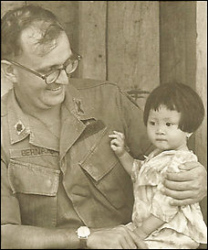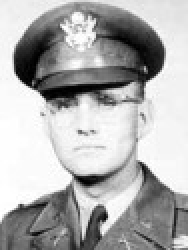
 |
|
|
||
|
Carl Franklin Bernard |
||||
|
Engagements: • World War II (1941 - 1945)• Korean War (1950 - 1953)• Vietnam War (1960 - 1973) |
||||
| Biography: | ||||
|
Carl Franklin Bernard Carl Franklin Bernard was born on 31 May 1926 in the oil-boom town of Borger, TX, and grew up in the oil fields during the Depression. At 18 years of age, Carl enlisted in the U.S. Marine Corps in 1944 and served in the Pacific Theater and China as an enlisted man during World War II. In 1947, he left the Marine Corps and joined the U.S. Army. In 1948, now-Army Corporal Bernard was assigned to discover why the members of the 555th, an African-American parachute regiment known as "Triple Nickel" did poorly on standardized Army tests. [According to his son Joel Bernard, his father got the assignment because he was "the nerdy, bookish, glasses-wearing guy at 82nd Airborne Division Headquarters."] Carl quickly realized the answer to the problem was simple: No one had taught the men how to take such tests. He put together a program of test-taking skills, and soon the unit was achieving some of the highest aggregate test scores in the Army. Carl was then made an honorary member of the 555th "Triple Nickel" Regiment. Carl Bernard was commissioned as a Second Lieutenant of Infantry in the U.S. Army in 1949. In July 1950, Second Lieutenant Bernard was a Platoon Leader serving with Company L, 3d Battalion, 21st Infantry Regiment, 24th Infantry Division, in Japan. One day he was assigned to assist Task Force Smith, led by Colonel Charles B. Smith, in loading a plane for a trip to Korea shortly after the North Korean invasion of the south on the night of 25 June 1950. "Stay on the plane. I've got work for you," Smith told him. A week later, 2LT Bernard led a group of survivors through enemy lines and back to U.S. positions. On 10 July, 2LT Bernard's unit became engaged with enemy forces in the vicinity of Chochiwon, Korea, when Company L was attacked by a numerically superior enemy force, supported by armor. On his own initiative, 2LT Bernard organized and led a small patrol forward and engaged the enemy tanks, personally destroying two enemy tanks and dispersing two others with accurate 2.36-inch rocket fire. The next morning his company was ordered to withdraw because an enemy regiment had encircled their positions. Single-handedly and with complete disregard for his own safety, 2LT Bernard, with his carbine and hand grenades, attacked an enemy machine gun that was blocking his company's only withdrawal. He advanced through the heavy small-arms fire and killed four enemy soldiers with carbine fire and destroyed the machine gun and crew with hand grenades, opening a route of withdrawal. 2LT Bernard then organized the stragglers into a fighting unit and placed them in new defensive positions to cover the battalion's withdrawal. Lieutenant Bernard's personal attacks against the enemy tanks and machine-gun emplacement inspired the outnumbered men of his command to fight with him, against overwhelming odds, until they were out of ammunition. 2LT Bernard's extraordinary heroic actions and inspiring leadership earned him the U.S. Army's second highest award for valor, the Distinguished Service Cross. Bernard's assignments, after Korea, included command of an Infantry company in Germany; attending the Ranger School at Fort Benning, GA; and attending the Command and General Staff College at Fort Leavenworth, KS. He also helped develop the curriculum at the John F. Kennedy Special Warfare School at Fort Bragg, NC. In 1960, Bernard was dispatched to Laos, where he worked with CIA officer William E. Colby in villages of the Hmong hill tribes as part of the White Star Mobile Training Teams. He developed an affinity for the Hmong people and became their tireless advocate. He also became a persistent critic of what he considered the U.S. government's abandonment of the Hmong to the Pathet Lao communists after the fall of Saigon. Colonel Bernard was assigned the task of restoring an Army ROTC program at the University of California at Berkeley in 1972. The task was a difficult one since the revival of the ROTC at Berkeley was only due to pressure from the federal government. However, Bernard said that his work there was his proudest accomplishment. Colonel Bernard retired from the Army in 1978. Post-Military Life In retirement, Bernard operated a consulting firm. Education ● University of Kansas - Bachelor of Science degree in Asian Studies - 1960 Medals, Awards, Badges and Tabs Distinguished Service Cross Distinguished Service Cross Citation The President of the United States of America, under the provisions of the Act of Congress approved July 9, 1918, takes pleasure in presenting the Distinguished Service Cross to Second Lieutenant (Infantry) Carl F. Bernard, United States Army, for extraordinary heroism in connection with military operations against an armed enemy of the United Nations while serving with Company L, 3d Battalion, 21st Infantry Regiment, 24th Infantry Division. Second Lieutenant Bernard distinguished himself by extraordinary heroism in action against enemy aggressor forces near Chochiwon, Korea, on 10 July 1950. On that date, when Company L was attacked by a numerically superior enemy force, supported by armor, Second Lieutenant Bernard, voluntarily and on his own initiative, organized and led a small patrol forward and engaged the enemy tanks, personally destroying two enemy tanks and dispersing two others with accurate 2.36-inch rocket fire. The following morning when his company was ordered to withdraw before an estimated enemy regiment which had encircled their positions, Lieutenant Bernard, single-handedly and with complete disregard for his own safety, attacked with his carbine and hand grenades, an enemy machine gun which was blocking his company's only route of withdrawal. Lieutenant Bernard with extreme calmness advanced through the heavy enemy small-arms fire and killed four enemy soldiers with carbine fire and destroyed the machine gun and crew with hand grenades, opening a route of withdrawal. Lieutenant Bernard then collected stragglers, organizing them into a fighting unit and placed them into new defensive positions to cover the battalion withdrawal. Lieutenant Bernard's aggressive attacks on the enemy tanks and machine-gun emplacement inspired the outnumbered men of his command to fight with him, until out of ammunition, against overwhelming odds. The extraordinary heroism displayed by Lieutenant Bernard reflects great credit on himself and is in keeping with the highest traditions of the military service. General Orders: Headquarters, Eighth U.S. Army, Korea: General Orders No. 45 (January 22, 1951) Family Carl's first marriage, to Barbara Browne, ended in divorce. The marriage produced two children, Mary and Hugh. His marriage to Edith Jouanin Bernard produced two sons, Joel and Jacques. Death and Burial On 4 March 2008, at his home in Fort Belvoir, VA, Colonel Carl Franklin Bernard lay down for a nap with a book of Korea in his hand. He never woke up. "For an old soldier, it was the perfect way to go," his son, Joel Bernard, said. Carl is buried at Arlington National Cemetery in Arlington, Arlington County, VA, in Section 36, Site 92. http://www.findagrave.com/cgi-bin/fg.cgi?page=gr&GRid=27029205 [This biography contains excerpts from an article in the Washington Post on 11 March 2008, written by Joe Holley, Washington Post Staff Writer http://www.washingtonpost.com/wp-dyn/content/article/2008/03/10/AR2008031003058.html.] |
||||
| Honoree ID: 309299 | Created by: MHOH | |||
Ribbons
Medals
Badges
Honoree Photos
 |  |  |
 |  |
 |


